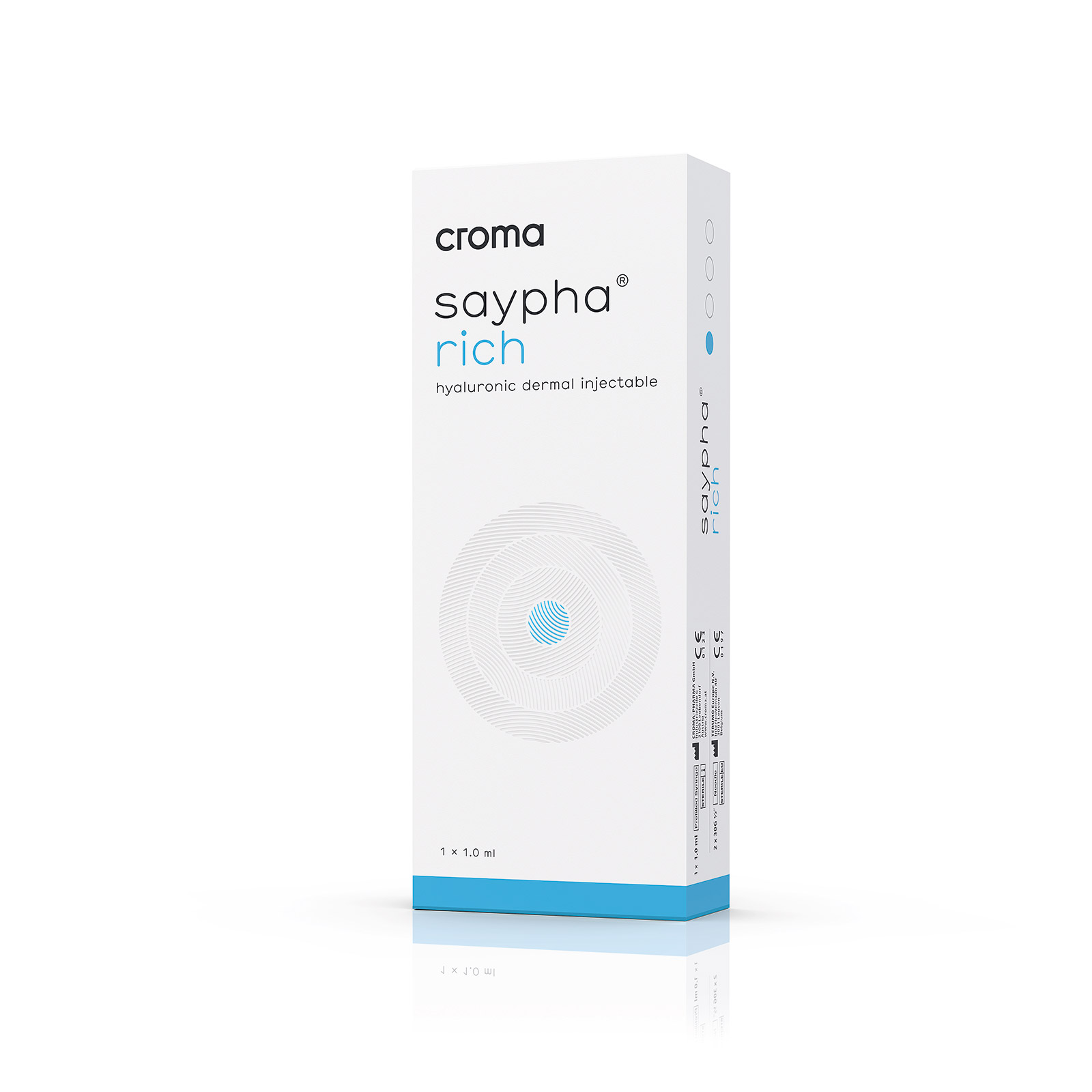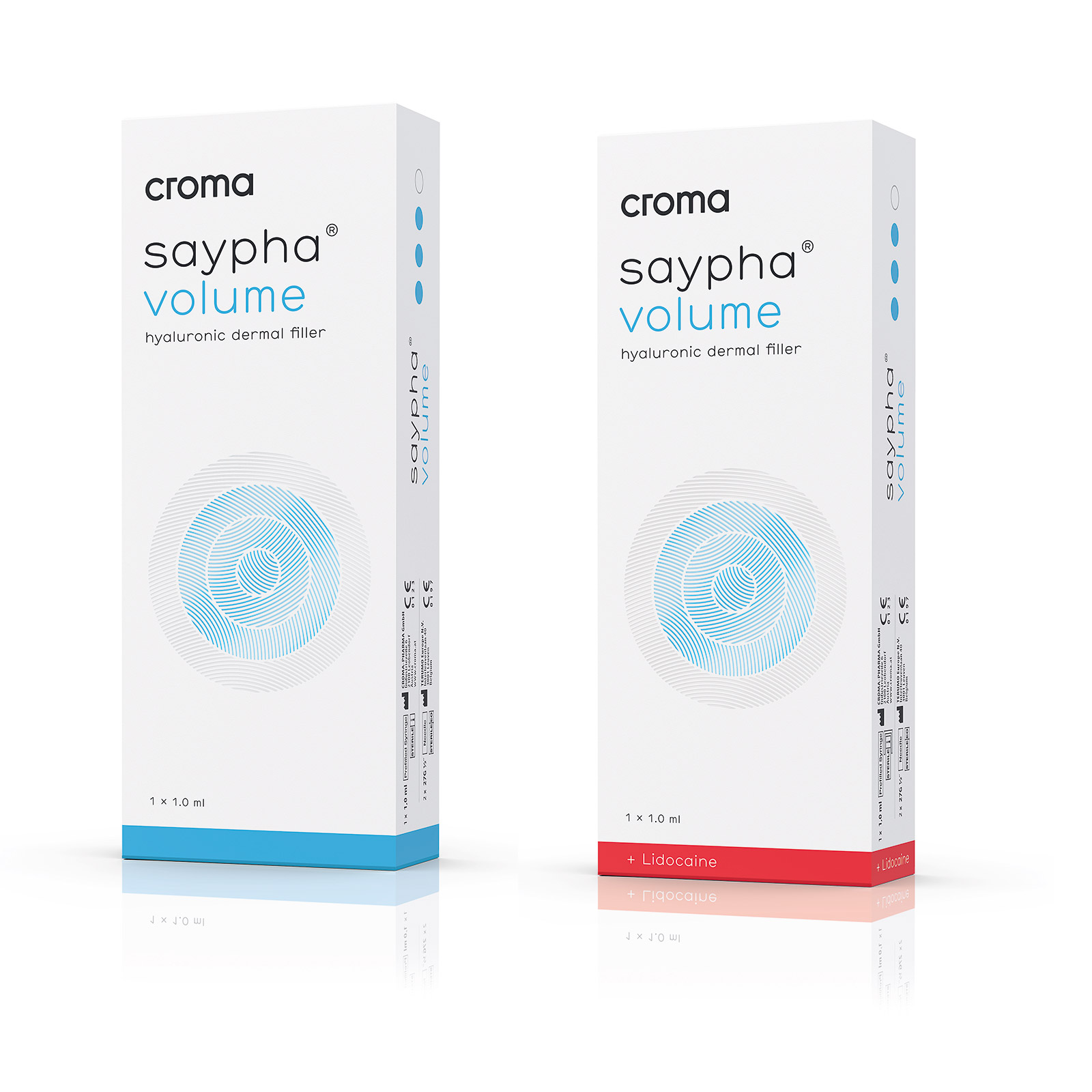Hyaluronic Acid Fillers
What is HA
Hyaluronic acid (HA) is one of the most popular ingredients in skincare treatments. Injectable hyaluronic acid (HA) is a type of temporary dermal filler.
- HA is found naturally throughout the body, with the highest concentrations in the joints, eyes, and skin. In the skin hyaluronic acid attracts water, which allows the skin to become more hydrated. As we age, the fat, muscles, bone, and skin in our face begins to slim. This loss of volume leads to sagging appearance of the face, make the face look tired, sad, angry, or even old.
- Injectable HA is used to create structure, and framework, to give volume to the face. Reducing the appearance of fine lines and wrinkles, and facial folds.

Hyaluronic Acid Filler Products
Saypha® Hyaluronic Acid Dermal Fillers usher in a new age of luxury. Luxury the way that you want it – a complete experience designed around the needs and desires for today’s aesthetic patients and practices.
Injected by a qualified Aesthetic Healthcare Professional, saypha® dermal filler treatments are considered non-surgical providing natural looking results.
Begin a new journey with saypha’s® unique and progressive vision inspired by the Aesthetic NEXT Generation.

Saypha® Rich
The device is a viscoelastic solution to replenish the loss of hyaluronic acid due to ageing, to maintain hydration, improve tone and elasticity of the skin and to act as a filler for small lines such as crow‘s feet, smile lines or smoke lines surrounding the mouth.
Saypha® Filler
For correcting light to moderate nasolabial folds. Used for cosmetic and medical reconstructive purposes in the treatment of e.g. facial lipoatrophy, debilitating scars or morphological asymmetry.


Saypha® Volume
For correcting moderate to deep nasolabial folds and medical reconstructive treatment, for instance, of facial lipoatrophy, debilitating scars, or morphological asymmetry.
Saypha® Volume Plus
The intended purpose of the device is to restore facial volume to correct moderate to severe midface volume deficit to treat signs of ageing.

Benefits
Natural results
Treatments are preferred by patients because they deliver effective and natural results with a solid scientific background for the highest quality standard. In addition to the demand for professional knowledge and the combination of different minimally invasive techniques for optimal results, they also emphasize the need for comprehensive medical assessment and a tailor-made treatment plan.
Pain-free & safe
“Minimally invasive” also means minimal bruises to the tissue and, therefore, almost no pain. The use of completely resorbable products with the highest tissue tolerability also minimizes the treatment risk.

No surgery, no down time
The ongoing development of minimally invasive aesthetic treatment methods now leads to results that were previously achieved only with surgical methods. Minimally invasive treatments have surpassed surgical methods in many areas and score outstanding results without either hospitalization, the risks of surgery or down time. Croma-Pharma offers a complete range of HA fillers that are injected by a qualified medical professional into specific dermal layers of the skin.
Hyaluronic Acid Filler FAQ
Croma HA filler treatments are non-surgical, granting minimal recovery time and ensuring, immediate, natural-looking results. Depending on your skin and individual wishes, the practitioner will choose the most suitable product from the Croma HA filler range to fulfill your needs and expectations. The resemblance of naturally occuring HA in the human body and Croma HA fillers means no preliminary allergy testing is necessary. The procedure is quick and easy. The injection itself may only take about 15 to 30 minutes. You will be able to return to your daily activities immediately afterwards.
Most people find filler injections quite painless. The addition of lidocaine, a mild anaesthetic, to certain products makes the injection even more comfortable for you. In addition, Croma HA fillers are placed in your skin by using thin wall needles which are specially designed for optimal patient comfort. An anaesthetic cream or local anaesthetic injection can be applied additionally depending on the area to be treated and your sensitivity.
The results of an aesthetic treatment with Croma HA fillers are long lasting, but not permanent. Depending on the product used, the injection area and your individual dispositions of the skin, the results can last for several months up to a year.
Before treatment
- It is important to talk about your expectations and wishes with your aesthetic practitioner before going ahead. You will be asked to inform your doctor about your previous medical history and prior aesthetic treatments with other products. In the week prior to the treatment with Croma HA fillers, you should not take any platelet aggregation inhibitors (such as Aspirin™, Marcoumar™ etc.) or anti-inflammatory medication in order to reduce the risk of bruising and bleeding at the injection site.
- In order to achieve optimum treatment results, you should allow your skin to rest and not touch the treated areas on the day following treatment, not apply any make-up to the treated skin areas for at least 12 hours, avoid sunbathing and high temperatures as well as saunas and steam rooms for the first week after treatment. In case you experience any post-treatment discomfort, you can apply an ice-pack for a brief period on the injection site to help soothing any swelling.
After treatment
- In order to achieve optimum treatment results, you should allow your skin to rest and not touch the treated areas on the day following treatment, not apply any make-up to the treated skin areas for at least 12 hours, avoid sunbathing and high temperatures as well as saunas and steam rooms for the first week after treatment. In case you experience any post-treatment discomfort, you can apply an ice-pack for a brief period on the injection site to help soothing any swelling.
Treatments with Croma HA fillers must not be used for:
- people who tend to develop hypertrophic scarring or have a susceptibility to keloid formation
- people with a history of auto-immune disease or who are receiving suppressants or immunotherapy
- people who are known to be hypersensitive to hyaluronic acid, lidocaine hydrochloride or to amide-type local anesthetics
- women who are pregnant or breast feeding
- people under 18 years
- people with infections or inflammations (acne, herpes, …) in the skin areas to be treated
- people receiving platelet aggregation inhibitors should not be treated without consulting their doctors
- people who have previously received permanent fillers in the area to be treated
- in areas presenting cutaneous, inflammatory and/or infectious processes (e.g. acne, herpes …)
- people who underwent a laser therapy, chemical peeling, dermabrasion or mesotherapy
- Croma is a leading specialist for injectable hyaluronic acid and applies the highest standards in order to guarantee the best quality and safety. Please bear in mind that the use of Croma HA fillers – despite its optimal quality – may cause some post-treatment discomfort or side effects, which can appear immediately after the injection or after a few days.
- There may be mild reddening and swelling at the injection sites, which will normally disappear on their own after a few hours. Apart from light bleeding due to the injection, mild oedemas or erythemas can develop, which can be itchy or painful on pressure. In rare cases, small hematomas, indurations and nodules can form in the treated areas, which will dissipate within a few days. These reactions can last for one week. Please inform your aesthetic practitioner if inflammatory reactions or other adverse events last for more than one week, so that they can be adequately treated*.
- * The following events and reactions have been observed with similar products: abscess, angioedema, bacterial infections, beading/lumpiness, bleeding, bruising, burning, discoloration (dispigmentation), discomfort, edema, erythema, puncture marks, mass formation, firmness, granulomas, hematoma, herpes reactivation, hypersensitivity, implant-site mass, implant visibility, induration, inflammation, irritation, itching, livedoid pattern after accidental arterial embolization, malar edema, migration, necrosis due to vascular compromise, nodules (inflammatory and non inflammatory), numbness, pain, paresthesia, redness, retinal artery occlusion, scar sarcoidosis, scleromyxedema (generalized), swelling, telangiectasia, tenderness, vasculitis, vasospasm, vasovagal reaction during injection, vision loss due to retinal artery occlusion (in very rare cases).
